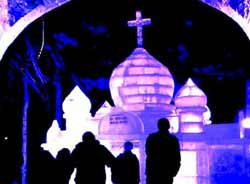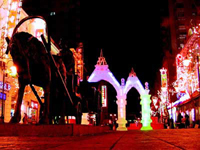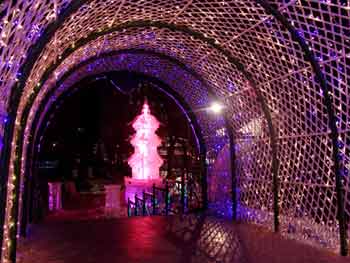There are two ways to escape the dreary Shanghai winter. Either you flee to sunnier parts and sip Mai Tais on the beach, or you embrace the cold and make it your own. If you want to experience real frosty conditions, there's no better place than Harbin, in China's most northeasterly province of Heilongjiang.
Granted, the self-proclaimed 'city of ice' seems to be having a 'warm' winter this year; there is, surprisingly, no snow on the ground, though temperatures still range from a brisk -15 to -17 Celsius (3-5 Fahrenheit) at daytime, to below -20C (-4 F) during the night. With those numbers in mind, pack all the warm clothes you own so you can enjoy in comfort a weekend trip to the famous Harbin Snow Sculpture and Ice Lantern Festival.
The Festival, held annually since 1963, attracts visitors from around the globe. If you fly in on a Friday night, you might want to start your first day in the city by watching brave Harbin residents enjoying a 10am ice-swim at the winter swimming pool near Songhua River bridge (enter through the icebound boat). Taking a dive and crossing a roughly 20-meter pool with water temperatures at 4C (40 F) might instantly kill the inexperienced-either from heart attack or exposure-but the well-trained Harbin swimmers (including one 77-year-old woman) seem to genuinely enjoy their icy hobby. Indeed, they swear by its positive effects on their health.
Now that you're somewhat acclimatized, continue to the snow sculpture park in Sun Island Park (taiyangdao gongyuan), where you'll find more than 2,000 sculptures, built from roughly 20,000 cubic meters of ice and 8,000 cubic meters of artificial snow. The ice artists have chosen themes ranging from Western fairytale characters and classical masterpieces to Buddha statues and life-size houses. The grand finale consists of a replica-though not quite to full scale-of Canada's Niagara Falls.
Also located on Sun Island is the Siberian Tiger Park. Rangers will take you on a 30-minute pseudo-safari through the prison-like compound and let loose some live chickens to lure the slumbering cats towards, or even to the top of your vehicle. After this spectacle, amble through an enclosed walkway where you can sacrifice some poor fowl yourself. This experience is certainly in dubious taste, and the condition of the cages is a disgrace, but seeing these beautiful felines (including more than 300 Siberian tigers, lion tigers, black panthers, pumas and one white tiger) up close is worth the trip.
After dusk, put on an additional layer of clothing and head out to the Ice Lantern Festival (bing deng jie). This impressive collection of ice sculptures the size of temples, pagodas and palaces comprises one of the world's four largest ice and snow festivals (along with Japan's Sapporo Snow Festival-see Excess Baggage, P58-Canada's Quebec Winter Carnival, and Norway's Ski Festival). At Harbin, the sculptors start building their gigantic 'ice lanterns' in December. Multi-colored neon lights embedded in the sculptures turn the village into a winter wonderland, which lasts from the opening ceremony on January 5 until February 25 (officially), but in practice extends until early March when the ice starts melting and the collapsing ice buildings become life-threatening before finally reuniting with the waters of the Songhua River. Allow two to three hours to traipse through this amazing city of ice, which includes replicas of a European Catholic cathedral, a Russian orthodox church, a synagogue, Buddhist temples and pagodas, abstract UFO-like artworks, and an ice-gallery of calligraphy. Don't miss the fun of sliding down a few ice-chutes, and try one of the colorful glazed fruit sticks sold everywhere-they taste even better when slightly frozen.
After indulging in so much childish pleasure during the first day of your stay, it's time for one of the darker chapters in Harbin history on the second: the war crime memorial at the former headquarters of the Japanese Imperial Army Unit 731, a covert special army unit that conducted medical experiments on humans from 1935 until 1945. An estimated 3,000 to 10,000 Chinese (mostly Manchu) prisoners of war died in Harbin from exposure to frostbite, amputations, vivisections and forced germ infection. The research results were used to breed plague-carrying lice (transported on rats), as well as pathogens such as anthrax, typhoid, dysentery and cholera. The latter were then utilized in biological warfare attacks on Ningbo (1940) and Changde (1941). At the time of the Japanese retreat, most of the Harbin buildings were destroyed and all remaining inmates killed and then cremated by the retreating Japanese in 1945. However, the remaining structures, and the rather well composed exhibition hall, offer an informative insight into one of the lesser known chapters of WWII.
After this gruesome learning experience, one relishes returning to the charming downtown section of Daoli district. Use your last couple of hours to visit St Sophia Orthodox Church (sheng suofeiya jiaotang), built in 1903 in typical Byzantine style, and to stroll along Central Avenue (Zhongyang Dajie). This pleasant pedestrian zone hosts several European-influenced buildings, which suggests that Harbin only became a 'real' city thanks to the completion of the Russian Manchurian Railroad in the late 19th century (and the ensuing Russian immigration). One last suggestion: stack up on vodka (and caviar) at one of the Russian goods stores; once you arrive back in Shanghai, the beverage might be your only source of heat.
Travel Tips
For hassle-free booking of any of the itineraries outlined above, sign up for one of three trips with the Chinese Culture Club on Feb 2-4, 9-11 or 19-21. (www.chinesecultureclub.org/travel) China Eastern Airlines flight MU 5619 leaves Shanghai Pudong airport on Fridays at 8:55pm, arriving in Harbin at 11:30pm. A taxi ride to Central Avenue downtown takes 40-60 minutes. A return flight with Shanghai Airlines (FM 9174) leaves at 6:30pm on Sunday, arriving in Pudong at 9:15pm. Songhuajiang Gloria Inn Hotel (www.giharbin.com) is very conveniently located on Zhongyang Dajie near the Songhua River. If you don?ˉt like the Chinese breakfast buffet they serve, walk a few blocks to the Parisian bakery Caf¨| de EIFE (185 Zhongyang Dajie) for lattes and pastries in a cozy environment. The nicest caf¨| in town is the Russian Cafe (turn left at the KFC on Zhongyang Dajie, just one block from Gloria Hotel)-be sure to try their Russian borscht or piroshki. If you prefer neon, noise and nightlife, check out MATSA Club at 21 Zhaolin Lu.
(That's Shanghai by Sonja Bonin February 15, 2007)



